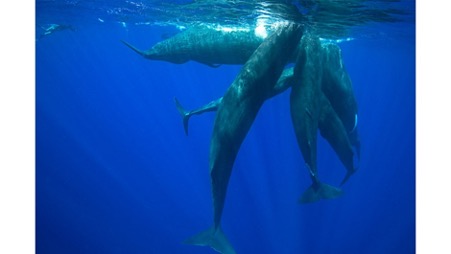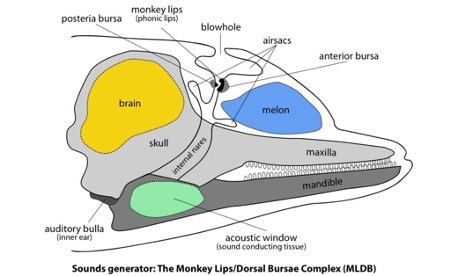Within the last few weeks, a ground-breaking new interdisciplinary project was launched that made headline news: Project CETI (Cetacean Translation Initative). An ambitious collaboration between marine scientists, linguists, and engineers, Project CETI will attempt to solve a mystery which has intrigued scientists around the world – what are whales saying to one another?
The project really began well over 10 years ago, when biologist and National Geographic explorer Shane Gero witnessed two male sperm whales interacting near his boat, off Dominica. Desperate to understand what they were saying to one another, he recorded hundreds of sperm whale interactions over the next 13 years, but never had the context to understand them. Gero’s work has become the backbone of Project CETI, which was announced earlier this month, with its aim being to decode and translate sperm whale language – potentially allowing us to eventually converse back. You can read more about it and the scientists involved here.
The project will involve a gargantuan recording effort, using robotics technology and listening stations (e.g. buoys and tags) to record sperm whale clicks. This data will then be sent to experts in the fields of linguistics, marine science, and data science, where it will be decoded using machine learning. Machine learning (ML) is a branch of artificial intelligence, whereby computers and other machines are given the ability to learn and discover how to complete tasks without being previously programmed to do so. The machine can then learn from the experience and improve the task independently. Whilst it may sound complex and futuristic, ML is already used in our day-to-day lives. For example, the spam filters on our email, or alerts from our bank when it perceives suspicious transactions. ML has been used to decode and produce language before, but never using non-human animals. This is mainly due to the fact that it requires huge inputs of data, or examples to work from. The robotics and recording initiatives in the CETI project look to overcome this and allow for the analysis and translation of whale language for the very first time. Specifically, Project CETI will focus on sperm whales; with their huge brains, complex sociality and multicultural group structures, strong family bonds, and demonstrable ‘thoughts and feelings’, they share a fair few similarities with humans. As a result, scientists anticipate they already possess a number of the skills necessary for complex language learning, and as a result are likely to have a highly evolved language (Janik, 2014).
However, complex communication is certainly not limited to sperm whales. Cetaceans as a group possess a huge range of communication styles and structures, including calls, clicks, pulsed sounds, whistles, low-frequency calls, and complex songs. In fact, cetaceans, along with a small number of other animals, are capable of not only producing sounds, but of vocal learning, a rare hallmark of complex language users.
Cetaceans as a group possess a huge range of communication styles and structures, including calls, clicks, pulsed sounds, whistles, low-frequency calls, and complex songs
In toothed whales (the odontocetes, including dolphins, sperm whales, porpoises, and beaked whales), clicks are usually used for echolocation purposes (to navigate and make sense of their surroundings) whilst calls, whistles, and pulsed sounds are used socially. These sounds are producing using paired ‘phonic lip’ structures (otherwise known as monkey lips!) in their heads and nasal system, due to the fact that cetaceans lack a larynx, which produces sound in terrestrial mammals. Pressure builds up in this system due to the contraction of pharyngeal and nasal muscles, and the resulting movement of air through the system and past the phonic lips produces the sound. It is thought that toothed whales might not use the paired lips together to produce the same sound, but instead use one side for clicking and the other for whistles (Madsen et al., 2013).
Dolphins have long been the subjects of study regarding vocal learning and marine mammal communication. Early research showed their propensity for vocal learning; they have the ability to learn whistle sounds given to them and assign them to objects. In other words, they can ‘name’ objects and other individuals, and use these ‘words’ referentially when interacting with another animal (Richards et al., 1984). Later research showed that individual dolphins possess signature whistles, which identify them from others in the group, much like a name. Studies have shown that dolphins understand their own signature whistle (Janik et al., 2006), and also learn the whistles of conspecifics and address them individually by matching their whistle type (Janik, 2000). Incredibly, they can understand these signature whistles even in the absence of voice or location cues, meaning they can utilise these labels referentially in situations without any context to guide them. Until this discovery, this was a feat only achieved by humans! Instead, they recognise whistle ‘shape’, or the frequency pattern in the call (Janik et al., 2006). By learning the signature whistles of their group, a pod can maintain and strengthen social cohesion and build strong bonds (Janik & Slater, 1998).
Vocal learning and matching are also important in cetacean culture, as well as sociality. Orca, or killer whales, are one of the best examples of a cetacean with complex and varied cultures. Whilst there is only one recognised species of orca, there are ten unique ecotypes, which differ based on morphology (or physical features, for example, the shape and size of their white eye patch), diet, range, body size, and social structure. Another defining feature of an orca ecotype is their vocalisations. Vocal repertoires differ between ecotypes, and even within ‘clans’ (groups) within each ecotype (for example, J, K, and L pods of the southern resident orcas). Differences lie in the syntax (the rules that govern how words combine or are arranged), syllables, and sound frequency of vocalisations (Yurk, 2005). As the social structure of orca is matrilineal (led by their older females), and pods are usually combined of closely related individuals, we might assume that the transmission of learning of these unique vocal systems within ecotypes and clans are simply passed down from mother to offspring. However, this is not the case! Vocalisation pattern, style, and frequency can be transmitted horizontally too, between unrelated adult animals (Deecke et al., 2000; Filatova et al., 2010), something that is rare in the animal kingdom. Like in other dolphin species, this vocal learning is likely to help maintain and develop social cohesion within groups, but also define them. Additionally, the difference in vocalisations between clans may also possess a reproductive purpose. As orca pods are often highly related, the risk of inbreeding is high, which decreases genetic diversity. It is thought that features identifiable in the vocal structure of a different clan (e.g. dissimilar syntax to your own) may help individuals to identify mates of low genetic similarity that are ‘safer’ to breed with, which is important for animals that do not breed outside of their ecotypes or cultural group. Incredibly, orca have also been found to recognise and imitate human speech sounds, demonstrating their ability to not only learn new vocalisations of their own kind, but also mimic (Abramson et al., 2018). They occasionally show mimicry within their own kind, for example, imitating calls from conspecifics in different clans, though this is rare (Weiß et al., 2010).
Whilst toothed whales click and whistle, baleen whales are known for their booming low frequency sounds. More often solitary or travelling in small numbers, low frequency sounds are more useful for long-range contact under the water. These sounds range from grunts and thumps to boings, belches, and trills – some very strange underwater noises have been attributed to whales! Unlike the toothed whales, it is thought that this sound production does come from the larynx. Structures within the throat, including a laryngeal sac and U-fold (which acts almost like a vocal cord) create the environment in which air can vibrate through to produce sound (Damien et al., 2018). However, the most sophisticated and iconic of these is whale song; instead of single emissions of sound, song is formed by the complex hierarchical building of notes, units, and themes. Four to six ‘units’ of sound (that is, a single emission of noise, with a varying frequency, pitch, or amplitude) are grouped together as a sub-phrase, and together two sub-phrases form a full phrase. Repeated phrases are known as themes. A full whale song consists of multiple themes and is repeated on a loop for hours to days. Only a few species are known to sing, the most famous being the humpback whale.
Whilst whale song is not new to scientists, exactly why what these sounds and songs might be used for is still up for debate. Sounds may communicate information about location, migration, threats, or act as greetings. Songs, meanwhile, are hypothesised to be related to mating and sexual selection; males sing during mating seasons and in the presence of unpaired females, but it’s not known exactly whether this is to compete or communicate with fellow males or attract potential female mates. Studies suggest that singing may have the drawback of attracting competing (even sexually immature) males wanting to get a look-in at another whale’s chosen female! (Smith et al., 2008; Herman et al., 2013).
As in toothed whales, baleen whales demonstrate great propensity for vocal learning. Songs are a great example of this; individuals learn songs from other animals in their same geographical area. This learning style is reflected in the fact that songs usually differ substantially between distinct populations. Songs subtly change over time (e.g. the addition of a new repeated element or unit), but learning can also happen quickly and radically in a ‘revolution’, where songs change almost entirely over a short period of time and involve animals learning huge amounts of new material at once (Noad et al., 2000). Like when we learn a new skill and have to start from the basics, the complexity of these songs decreases after a revolution (Allen et al., 2018). Amazingly, these revolutions can occur over huge geographic distances, involving animals from various populations that would otherwise rarely interact. It is thought that the meeting of different populations in areas close enough that one whale may be able to hear another, for example, occasional singing in high-latitude feeding grounds, might explain how new songs can be transmitted so quickly (Garland et al., 2013). This is one of the best examples in nature of cultural transmission.
If Project CETI is successful, it will give us an unparalleled look into the lives of one of our most complex cetaceans. However, this will be only one piece of the puzzle. With so many species, social structures, behaviours, and communicative styles, the mysteries of cetacean communication still remain very much undiscovered. What we can appreciate, however, is the remarkable skill and complexity of these animals, in way they learn, teach, and use their own language. Check out our related blogs on underwater noise for more information about the risks of anthropogenic sound on these complex creatures.
Lucy Sea Watch Foundation volunteer Feature Blogger @lucwhyy
Sources:
Janik, V. (2014). Cetacean vocal learning and communication. Current Opinion in Neurobiology, 28, pp.60-65.
Janik, V. and Slater, P. (1998). Context-specific use suggests that bottlenose dolphin signature whistles are cohesion calls. Animal Behaviour, 56(4), pp.829-838.
Weiß, B., Symonds, H., Spong, P. and Ladich, F. (2010). Call sharing across vocal clans of killer whales: Evidence for vocal imitation?. Marine Mammal Science, 27(2), pp.E1-E13.


























